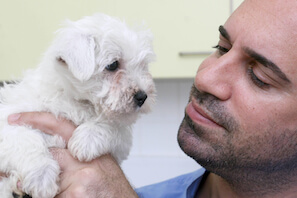Welcome to Petplan’s blog, a space where you can read up on the latest pet-news, find out interesting facts and tips about keeping your pets happy and healthy, and share your views on hot topics.
Refine articles by
clear search- Behaviour problems
- Veterinary problems
- Diet
- TitBits- news and more
- PetPeople magazine archive
- Petplan customer stories
- Travel
- Debates
- Advice
- Petplan feature
- Breed profile
- Health
- Petplan Prize Draw Winner
- Petplan Checklist
- Stories from the surgery
- Petplan Debate
- Charity partnerships
- Awards
- Rehoming
- cat
- dog
- rabbit
- adult
- senior
- puppy
- Lifestyle-sub-category
- Behaviourists-corner
Pyometra: what to look out for

Neutering: behind the scenes

Neutering your pedigree cat - when's the right time?

Q: We recently bought a male British Shorthair cat. We've always had our kittens spayed or neutered by around six months old, but we've been told that pedigree cats need to develop all their pedigree characteristics first. Is this true?
A: Breeders will have all sorts of advice when it comes to treating their kittens, but one thing that obviously goes against 'breeding' is to neuter. Your British Shorthair should reach maturity by six months and will continue to grow even if you castrate him at that time. In my opinion, the benefits of neutering outweigh any potential concerns and male cats of around that age can begin to stray, fight and scent mark - not attributes that many owners will desire for a house cat. Take your British Shorthair to the vet at six months and decide together what is best for him.
Scott Miller, vet
Does spaying affect a cat’s coat?

Q: My beautiful Bengal cat Lydia is about six months old and I’m thinking of getting her spayed. The breeder said to be careful where the vet clips her for the surgery, as this could affect the colour of her coat. If this is true, what can I do about it?
A: I have seen this happen in the occasional cat, and I must say I’m not certain why. It is likely that the clippers irritate the skin and cause melanin, the skin’s natural skin pigment, to be produced, or that clipping disrupts the normal cycles of hair growth and moulting, leading to the patch of coat regrowing with a slightly different colour.
With cats such as Bengals, whose coats are prized for being so delicate and beautiful, it’s best to have them spayed via a midline incision over the belly, where any change in coat colour will not be as noticeable. Strangely, this unusual reaction does not seem to happen as much in domestic breeds as in more exotic varieties such as beautiful Lydia, but spaying is a good idea for all cats, so speak to your vet about your concerns before the procedure is completed.


